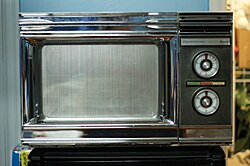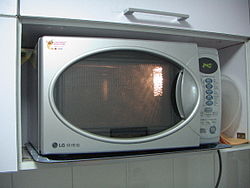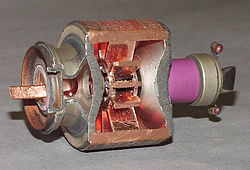Microwave oven
A microwave oven (commonly called a microwave) is a machine that cooks food using microwaves, a type of radio wave. The idea was invented when a scientist who was experimenting with radio waves saw his chocolate bar, which was in his pocket, had melted. He then knew that radio waves could cook food and invented the microwave oven. [1]
History
In 1945, the heating effect of a high-power microwave beam was accidentally discovered by Percy Spencer, an American self-taught engineer from Howland, Maine. Hired by Raytheon at the time, he noticed that microwaves from an active radar set he was working on started to melt a chocolate bar he had in his pocket. First, Spencer deliberately cooked popcorn with a microwave oven. And the second time, he cooked an egg, which exploded in the face of one of the experimenters.[2][3] [4]
To prove his finding, Spencer created a high-density electromagnetic field by feeding microwave power from a magnetron into a metal box from which it had no way to escape. When food was placed in the box with the microwave energy, the temperature of the food rose rapidly. On 8 October 1945, Raytheon filed a United States patent application for Spencer's microwave cooking process, and an oven that heated food using microwave energy from a magnetron was soon placed in a Boston restaurant for testing.[5]
How it works
The microwave oven uses a magnetron, which is a type of vacuum tube. This is similar to a radio transmitter. It makes very short radio waves which go into the food to a depth of about 2.5cm (one inch). This makes water molecules twist about 2.5 billion times a second. This heats up the molecules around it. As they heat up the heat goes to the inside of the food. This process is called conduction. This also happens in a normal oven, but microwave energy goes deeper so that the food cooks much faster. In an ordinary oven, the energy stays mostly near the surface, so it takes more time.[6]
The microwave oven also has a waveguide, turntable, and a timer switch. When we place the food inside the chamber and turn the timer switch on, it sends a signal to the magnetron to send microwaves, as well as to the turntable to start turning. The microwaves of microwave ovens can heat foods containing polar molecules, such as water, as polar molecules are prone to the vibration effect caused by the microwaves. To heat the food evenly the microwave's turntable spins the food around. [7]

Metals will cause sparks in microwaves, instead of heating. This is because metals like to give away electrons, so when the microwaves "push" at their magnet-like electrons, instead of turning, they just give the electrons away. A bunch of electrons running off of metal is called electricity, and we see it in the form of sparks. [8] Dry foods like ramen will sometimes burn and start fires in microwave ovens if water is not used with the food. [9]
Microwave Oven Media
The cavity magnetron developed by John Randall and Harry Boot in 1940 at the University of Birmingham, England
Raytheon RadaRange aboard the NS Savannah nuclear-powered cargo ship, installed circa 1961
Finnish Fiskars microwave from 1965
1974 Radarange RR-4.*By the late 1970s, technological advances led to rapidly falling prices. Often called "electronic ovens" in the 1960s, the name "microwave oven" later gained currency, and they are now informally called "microwaves".
Simulation of the electric field inside a microwave oven for the first 8 ns of operation
Related pages
References
- ↑ "Melted Chocolate to Microwave". MIT Technology Review. Retrieved 19 August 2023.
- ↑ Gallawa, John Carlton (1998). "The History of the Microwave Oven". Archived from the original on 2013-05-31.
- ↑ Radar — Father of the Microwave Oven at YouTube
- ↑ "Melted Chocolate to Microwave". MIT Technology Review. Retrieved 19 August 2023.
- ↑ Spencer, Percy L., "Method of treating foodstuffs", US patent 2495429, issued 1950-January-24
- ↑ "Teaching the world to ping", The Independent, Thursday 12 May 2011; Viewspaper p.16
- ↑ "Microwave Ovens". FDA. 20 March 2023. Retrieved 19 August 2023.
- ↑ "We asked a physicist: Why can't we put metal in the microwave?". The Takeout. 24 November 2017. Retrieved 19 August 2023.
- ↑ "Microwavable ramen recalled due to fire, burn risks". WPRI.com. 4 January 2019. Archived from the original on 19 August 2023. Retrieved 19 August 2023.
Other websites
- Metamaterials for microwave shielding Archived 2012-12-25 at the Wayback Machine
| Wikimedia Commons has media related to Lua error in Module:Commons_link at line 62: attempt to index field 'wikibase' (a nil value).. |










